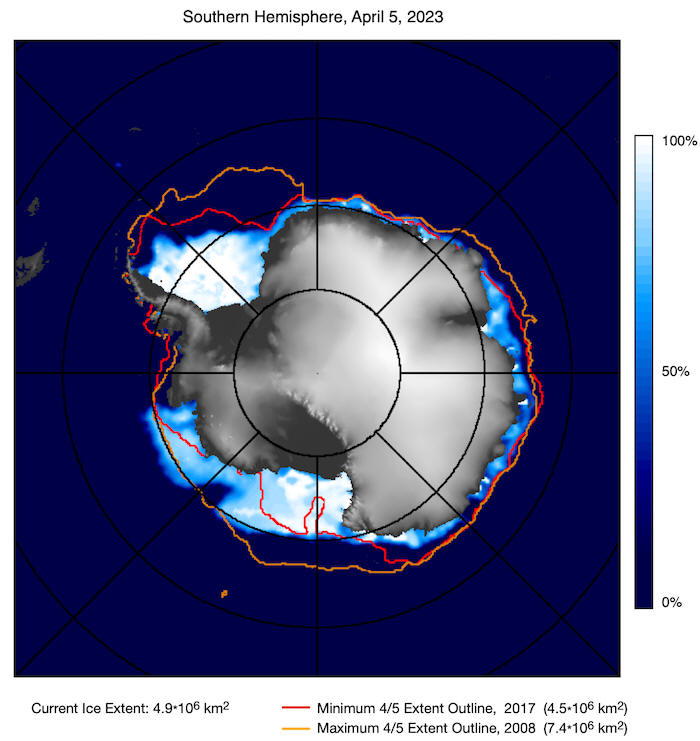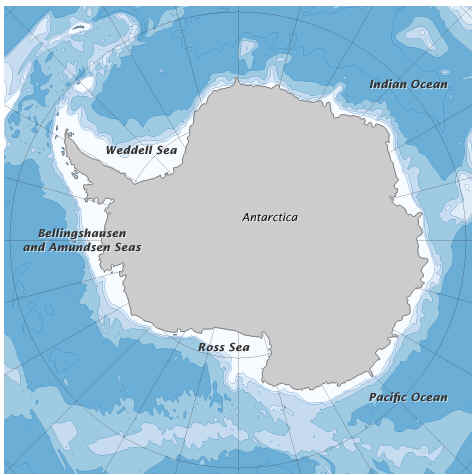
|
||||||||||||
|
|
Antarctic Sea Ice
The Antarctic is in some ways the precise opposite of the Arctic. The Arctic is an ocean basin surrounded by land, which means that the sea ice is corralled in the coldest, darkest part of the Northern Hemisphere. The Antarctic is land surrounded by ocean. Whereas Northern Hemisphere sea ice can extend to roughly 40 degrees north, Southern Hemisphere sea ice can extend to roughly 50 degrees south. Moreover, Antarctic sea ice does not extend southward to the pole; it can only fringe the continent.
In the Southern Ocean, sea ice fringes the entire Antarctic continent. Researchers typically subdivide Antarctic sea ice into 5 sectors, each influenced by different geography and weather conditions. Because of the geographic and climatic diversity, Antarctic sea ice is more variable from year to year than Arctic sea ice. (NASA map by Robert Simmon.)
Natural VariabilityAntarctic sea ice is distributed around the entire fringe of the continent—a much broader area than the Arctic—and it is exposed to a broader range of land, ocean, and atmospheric influences. Because of the geographic and climatic diversity, Antarctic sea ice is more variable from year to year than Arctic sea ice. In addition, climate oscillations don’t affect ice in all sectors the same way, so it is more difficult to generalize the influence of climate patterns to the entire Southern Hemisphere ice pack. Similar to the Arctic, the Antarctic experiences atmospheric oscillations and recurring weather patterns that influence sea ice extent. The primary variation in atmospheric circulation in the Antarctic is the Antarctic Oscillation, also called the Southern Annular Mode. Like the Arctic Oscillation, the Antarctic Oscillation involves a large-scale seesawing of atmospheric mass between the pole and the mid-latitudes. This oscillation can intensify, weaken, or shift the location of semi-permanent low- and high-pressure weather systems. These changes influence wind speeds, temperature, and the track that storms follow, any of which may influence sea ice extent. For example, during positive phases of the Antarctic Oscillation, the prevailing westerly winds that circle Antarctica strengthen and move southward. The change in winds can change the way ice is distributed among the various sectors. In addition, the strengthening of the westerlies isolates much of the continent and tends to have an overall cooling effect, but it causes dramatic warming on the Antarctic Peninsula, as warmer air from over the oceans to the north is drawn southward. The winds may drive the ice away from the coast in some areas and toward the coast in others. Thus, the same climate influence may lessen sea ice in some sectors and increase it in others. Changes in the El Niño-Southern Oscillation Index (ENSO), an oscillation of ocean temperatures and surface air pressure in the tropical Pacific, can lead to a delayed response (three to four seasons later) in Antarctic sea ice extent. In general, El Niño leads to more ice in the Weddell Sea and less ice on the other side of the Antarctic Peninsula, while La Niña causes the opposite conditions. Another atmospheric pattern of natural variability that appears to influence Antarctic sea ice is the periodic strengthening and weakening of something that meteorologists call “zonal wave three,” or ZW3. This pattern alternately strengthens winds that blow cold air away from Antarctica (toward the equator) and winds that bring warmer air from lower latitudes toward Antarctica. When southerly winds intensify, more cold air is pushed to lower latitudes, and sea ice tends to increase. The effect is most apparent in the Ross and Weddell Seas and near the Amery Ice Shelf. As in the Arctic, the interaction of natural cycles is complex, and researchers continue to study how these forces work together to control the Antarctic sea ice extent. Impacts of Antarctic Sea Ice LossA study on warming of West Antarctica since the 1957 geophysical year correlates widespread warming in West Antarctica and sea ice decline. Whether sea ice decline has led to warming temperatures on the continent, or whether both phenomena are caused by something else is not currently known. One concern related to potential Antarctic sea ice loss is that sea ice may stabilize Antarctic ice shelves. Ice shelves are slabs of ice that partly rest on land and partly float. Ice shelves frequently calve icebergs, and this is a natural process, not necessarily a sign of climate change. But the rapid disintegration and retreat of an ice shelf (such as the collapse of the Larsen B shelf in 2001) is a warming signal. Although sea ice is too thin to physically buttress an ice shelf, intact sea ice may preserve cool conditions that stabilize an ice shelf because air currents passing over sea ice are cooler than air currents passing over open ocean. Sea ice may also suppress ocean waves that would otherwise flex the shelf and speed ice shelf breakup. The interaction between sea ice loss and ice shelf retreat merits careful study because many ice shelves are fed by glaciers. When an ice shelf disintegrates, the glacier feeding it often accelerates. Because glacier acceleration introduces a new ice mass into the ocean, it can raise ocean level. So while sea ice melt does not directly lead to sea level rise, it could contribute to other processes that do, both in the Arctic and the Antarctic. Glacier acceleration has already been observed on the Antarctic Peninsula, although the accelerating glaciers in that region have so far had a negligible effect on ocean level.
,NSIDC |




